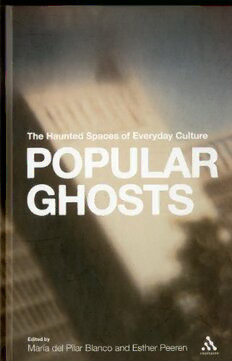
Popular ghosts : the haunted spaces of everyday culture PDF
Preview Popular ghosts : the haunted spaces of everyday culture
Popular Ghosts This page intentionally left blank Popular Ghosts The Haunted Spaces of Everyday Culture edited by María del Pilar Blanco and Esther Peeren The Continuum International Publishing Group Inc 80 Maiden Lane, New York, NY 10038 The Continuum International Publishing Group Ltd The Tower Building, 11 York Road, London SE1 7NX www.continuumbooks.com Copyright © 2010 by María del Pilar Blanco and Esther Peeren All rights reserved. No part of this book may be reproduced, stored in a retrieval system, or transmitted, in any form or by any means, electronic, mechanical, photocopying, recording, or otherwise, without the written permission of the publishers. Library of Congress Cataloging-in-Publication Data Popular ghosts: the haunted spaces of everyday culture / edited by María del Pilar Blanco and Esther Peeren. p. cm. Includes bibliographical references and index. ISBN-13: 978-1-4411-6369-1 (hardcover : alk. paper) ISBN-10: 1-4411-6369-7 (hardcover : alk. paper) ISBN-13: 978-1-4411-6401-8 (pbk. : alk. paper) ISBN-10: 1-4411-6401-4 (pbk. : alk. paper) 1. Ghosts. 2. Haunting. 3. Popular Culture. 4. Everyday Life. I. Blanco, María del Pilar. II. Peeren, Esther. III. Title. BF1461.P67 2010 133.1--dc22 2009028514 Typeset by Free Range Book Design & Production Printed in the United States of America Contents Introduction ix María del Pilar Blanco and Esther Peeren Part One Genealogies of the Ghost 1 1 Ghosts: Of Ourselves or, Drifting with Hardy, Heidegger, James, and Woolf 3 Julian Wolfreys 2 Beckett’s Ghost Light 19 Martin Harries 3 Uncanny Marxism: Or, Do Androids Dream of Electric Lenin? 35 Peter Hitchcock 4 Where Are the Dead? A Genealogy of Mediumship in Victoria Glendinning’s Electricity 50 Justin Sausman 5 The Skeptical Ghost: Alejandro Amenábar’s The Others and the Return of the Dead 64 Colin Davis Part Two Spectral Politics of the Contemporary 77 6 National Hauntings: Specters of Socialism in Shree 420 and Deewar 79 Caroline Herbert 7 Shadow of the Colossus: The Spectral Lives of 9/11 94 Georgiana Banita 8 Everyday Ghosts and the Ghostly Everyday in Amos Tutuola, Ben Okri, and Achille Mbembe 106 Esther Peeren v vi PoPular GHoSTS 9 The Gentle Irruption of the Hereafter in This Life: Jean Echenoz’s Au piano and Robin Campillo’s Les revenants 118 Michael Cuntz 10 Specters of the U.S. Prison Regime: Haunting Tourism and the Penal Gaze 133 Benjamin D’Harlingue Part Three Chasing Ghosts In(to) the Twenty-first Century 147 11 The Liveness of Ghosts: Haunting and Reality TV 149 Karen Williams 12 Ghost Hunters: Simulated Participation in Televisual Hauntings 162 Alissa Burger 13 The Haunted Lecture Theater: Ghosts in the Academy in the BBC’s Sea of Souls 175 Catherine Spooner Part Four Other Ghostly Spheres 185 14 Genius Loci: Memory, Media, and the Neo-Gothic in Georg Klein and Elfriede Jelinek 187 Arno Meteling 15 Haunted Habitability: Wilderness and American Haunted House Narratives 200 Christine Wilson 16 Gothic Affects: Digitally Haunted Houses and the Production of Affect-Value 213 Bruno Lessard 17 Ghosts in the Machine: The Body in Digital Animation 225 Alla Gadassik 18 The Ghost Worlds of Modern Adolescence Pamela Thurschwell 239 Part Five Ambient Ghosts: Spectral Images, Sounds, and Bodies 251 19 The Haunting of the Everyday in the Thoughtographs of Ted Serios 253 María del Pilar Blanco 20 “Following the Ghost”: The Psychogeography of Alternative Country 268 Anthony Hutchison Contents vii 21 Haunted by a Melody: Ghosts, Transgression, and Music in Twin Peaks 282 Isabella van Elferen 22 Occultic Inscriptions: The Modern Ghost-Tattoo in Japan, from Kyôsai to Horiyoshi III 296 Sean Somers Select Bibliography 311 Contributors 321 Index 325 This page intentionally left blank Introduction María del Pilar Blanco and Esther Peeren … every period has its ghosts (and we have ours), its own experience, its own medium, and its proper hauntological media.1 Well, what do you know? The place is haunted.2 It seems that ghosts are everywhere these days. Whether in rock songs, Internet news feeds, or museum exhibits, we appear to have entered an era that has reintroduced the vocabulary of ghosts and haunting into everyday life. The drafting of this introduction happened to coincide with the appearance of the inaugural issue of a British magazine called Ghost Voices: The Magazine of All Things Haunted. The discovery of such a publication on the shelves of a popular newsagent in northern England represents an unabashedly paramount moment in the history of the topic we set out to explore in this collection. When ghosts, and the search for ghosts, reach such a level of popularity qua normality, or – better put – when the word “ghosts” is seen alongside magazine covers featuring topics as far ranging as politics, brides, horse riding, and fashion, we can assume that a very important recognition has been established. This recognition is that ghosts, which, along with fantastic stories, the Argentine author Adolfo Bioy Casares rightly referred to as “old as time itself,” have entered, and are indeed part of, the popular realm.3 If ghosts are old, they are certainly not tired. While Ghost Voices features articles on what we could call “good, old-fashioned haunting” (haunted houses, mediums, and so on), we can also speak of new etymologies and epistemologies of haunting that are endemic to our global times. In April 2009, for example, the FBI caught a ring of Puerto Rican and Dominican identity thieves who had managed to infiltrate public schools to steal copious amounts of children’s personal information (including social security numbers and dates of birth) to produce false immigration documents for Dominicans trying to enter the U.S. Identity theft is our contemporary crime of “ghosting” others to unblock global passages that would otherwise remain unsurpassable. The idea that one person from a specific nationality can become the operative “ghost” of another (in this case a Puerto Rican child) in order to gain access to a new way of life independent ix
